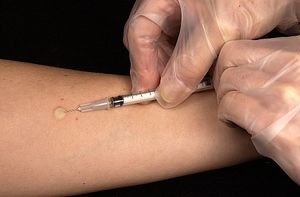The 11 member states of the WHO South-East Asia Region have opened a new front in the battle to end tuberculosis (TB) by 2030. That front is aimed at tackling TB infections before they develop into full blown disease – in other words, tackling latent TB, a problem that afflicts around one in every three people globally, and which becomes active (and potentially life threatening) in up to one in every 10 people. Across the Southeast Asian region, TB makes an estimated 4.4 million people sick every year, killing an upwards of 650,000.
The region’s new action plan to tackle latent TB, which was endorsed at the recently concluded WHO South-East Asia Regional Committee in New Delhi, India, will help reduce TB incidence by an additional 12-15 percent annually, equating to around 270,000 fewer cases each year. As such, the plan’s adoption marks a crucial new phase in the region’s quest to rout TB, and follows a raft of measures member states have taken in recent years, from more than doubling domestic investment in TB programs to intensifying active case finding, harnessing new technologies for diagnosis and treatment, and enhancing the uptake of people-centered care, including by providing nutritional and financial assistance.
Notably, the plan’s adoption also follows the 2018 High-level meeting on TB at the UN General Assembly, where member states issued a political declaration on the fight against TB. Among other targets, the declaration calls on governments across the world to treat at least 30 million people with latent TB by 2022. Given the Southeast Asia region’s disproportionate TB burden (it accounts for around 44 percent of all new TB cases, and upward of 50 percent of all TB deaths annually), global progress toward ending TB is dependent on Southeast Asia’s. On that score, member states are showing decisive leadership, not only in the health sector, but across government and at the highest levels.
So how exactly will latent TB be tackled?
First – and crucially – treatment for latent TB will be extended from select groups such as people with HIV and children under five who are contacts of TB patients to all people who live with a person with active TB. Under the new plan, both TB patients and their household contacts will be regarded as a single unit of beneficiaries, meaning patients with active TB will be provided anti-tubercular treatment while their contacts will be provided TB preventive therapy once active TB infection is ruled out. Both treatment regimens will be accessed from the same package of services.
Second, decisive efforts will be made to ensure gaps between the public and private sectors are filled. While private providers’ notification of active TB cases and the provision of standardized care has been strengthened, information regarding the treatment of latent TB in the private sector remains inadequate. That must – and will – change. To do that, member states will augment data platforms currently in place for active TB, while ensuring the recommended treatment regimen for latent TB is communicated to and utilized in the private sector.
Third, intensified efforts will be made to listen to and engage communities on their medical and information needs as they relate to TB, whether latent or active. To that end, recent community interactions have gathered a range of key insights, from the need to better leverage information that can persuade seemingly healthy people to initiate and complete preventive therapy to the potential for cured TB patients to act as treatment mentors. Of note is the value of promoting awareness and demand among high-risk groups, including by integrating key messaging into projects involving persons living with HIV, injecting drug users and sex workers.
Finally, to gauge progress in the roll-out of preventive TB treatment, as well as treatment adherence, monitoring will be scaled up as per WHO’s recently updated guidelines. This means ensuring all cases of latent TB are recorded and reported, and that treatment coverage and completion are documented. Importantly, it also means developing and utilizing digital treatment adherence tools, from SMS text services to video-supported treatment. Even as new (and shorter) treatment for all forms of TB are developed, supporting and monitoring adherence must be a core priority.
To do all this, member states must mobilize additional funding, on top of the unprecedented amount they have already invested. That requires extensive resource-mapping to ensure all opportunities at the domestic level are leveraged. It also requires tapping existing donors, as well as exploring new ones. The upcoming cycle of Global Fund grants, for example, hold immense potential to accelerate the plan’s rollout. So too does harnessing the “savings or efficiency gain” built in to existing grants. These and other opportunities – especially with regard to feasibility studies and operational research – must be taken full advantage of.
There is, after all, not a moment to lose. Across the Southeast Asian region, as across the world, TB has for too long brought illness, poverty and death to millions of people. It must end. The region’s new action plan to tackle latent TB will prove vital to achieving that outcome. The region has already shown itself a leader in spearheading momentum to address the problem. It continues to show itself a leader in addressing the problem itself. As the world’s most TB-affected region, we cannot afford anything less. We must accelerate progress and end TB’s unconscionable threat.
Poonam Khetrapal Singh is the Regional Director for WHO South-East Asia.

































